Falkirk Ice Rink was supposed to open with a spectacular ice carnival in the first week of September after the summer break in 1939. War was declared on 3 September and all such places of entertainment, including cinemas were initially closed. The government and the entertainment industry took stock and after much debate it was agreed that these venues were needed to maintain morale. Strict black-out regulations were enforced and very quickly the premises were adapted to the new situation. At the ice rink this meant painting the glass in the roof-lights black, installing curtains at the entrances, covering the windows in the external walls and the restaurant, arranging extra fire precautions and night watchers, and a number of other tasks. A week later it re-opened very simply and quietly. All the magnificence and tinsel of the ice carnival were lacking, but the carnival spirit was still in the air. Large numbers of skaters with boots over their shoulders came along. The hours of opening were reduced. The rink was open for two skating sessions each day from Monday till Saturday, the hours fixed being from 2.30 till 5pm and 7 till 10pm.
From October 1939 special concessions were granted to members of His Majesty’s Forces in quest of entertainment. That month an emergency meeting of the Scottish Ice Hockey Association was held at Falkirk to determine the way forward for that sport. This was one of the aspects of the rink that was most affected by the wartime supply problems. Details of the wartime arrangements relating to this will be found above under the previous section.

Before long a full programme of events was introduced. The smaller scale of the shows was more than made up for by the enthusiastic participation of the audiences. The make do and mend spirit of the period saw great innovation and those attending the ice rink had much enjoyment. On 29 November 1939 a crazy comedy was staged called “Carnival Costumes” which put the patrons in a festive mood. Over the Christmas season this was followed by children’s parties featuring special displays by the experts as well as barrel jumping. Fancy dress was very much the order of the day. New Year in 1940 brought a “glittering skating extravaganza” when the skating stars of the day performed. While general travel was much restricted, concessions were made for those few entertaining large audiences.
By and large the rest of the programme was little changed as the skating exhibitions involved just small numbers of people from outside of the area. In fact, the programme was augmented by entertainment promoted on a national level to keep the spirits of the public up. Radio stars from “Flotsam and Jetsam” appeared in March 1940 and the sound system allowed radio broadcasts to be made from Falkirk.
Falkirk Ice Rink remained well attended throughout the war and it was an ideal location for fund-raising efforts. Often this simply meant passing through the crowds with collection boxes or selling badges and the like. On a regular basis the management also gave free use of the venue for concerts performed by various charities, the proceeds of which went to those groups. In February 1941, for example, a special military night and carnival dance was held in aid of the Royal Army Service Corps Comforts Fund. Falkirk Royal Infirmary, the local Red Cross, Prisoner of War parcels, comforts for the forces, the Falkirk Ambulance Fund, and the Merchant Navy Fund were amongst those supported. Savings campaigns were also promoted and Salute the Soldier and Wings for Victory were both celebrated at the ice rink. One feature of the Salute the Soldier Week held in June 1944 at the Ice Rink was a tableau performance by the Girls’ Training Corps called “Salute by Youth.” By May 1943 a total of £3,300 had been raised for war and other charities from functions held at Falkirk Ice Rink.
It had always been the intention to use the Falkirk Ice Rink in the summer months for functions other than those involving ice and so a dance floor of 512 square yards was laid in its place and in June 1940 it re-opened as the “New Dance Palais.” Partly as a consequence of the war it was possible to secure the services of Joe Gibson and his London Band which specialised in modern music and jazz. Dancing began at 7.30pm when Joe Gibson and his London band opened with their signature tune “Moonlight and Roses.” Indoor gardens supplemented by flowering and evergreen shrubs formed the basis of the new decorative scheme. Lounge chairs and tables in various colours were scattered about. Later in the evening Sydney Evans and Betty Craig, the Scottish dance champions, demonstrated new dances including the Jitterbug. David Maclean was appointed floor manager and master of ceremonies.
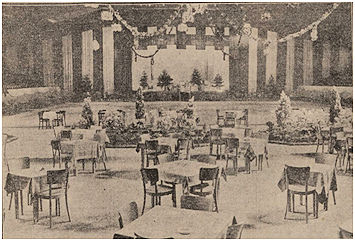
“Crazy Night” in June 1940 at the Falkirk Ice Rink Dance Palais proved outstandingly successful. There was good fun and the patrons entered into it with zest. Instead of prizes being presented to the successful competitors in the usual way, they took their own prizes from lucky dips. Some were fortunate enough to get valuable prizes, while others drew comedy toys such as, for example, a skipping rope with which to keep themselves fit. A go-as-you-please competition was also successful, followed by a novices’ foxtrot competition and an “All Scotch Night.”
So popular were the dances that when the winter season opened it was decided to retain part of the dance floor alongside the ice pad. The music of Joe Gibson and his London Band accompanied both dancers and skaters, but the daytime curling sessions were relatively silent. The rink was open for skating and dancing on three nights of the week, for skating only on Wednesday afternoons and Saturday mornings and afternoons, and for curling every Tuesday and Thursday.
Above all, the Falkirk Ice Rink became the go-to venue for the Hogmanay celebrations – though the need to catch buses and the terms of the drinking licence meant that the event finished comparatively early. The round of skating and dancing at the Hogmanay Night Carnival went on till 11 o’clock and then many went home!
Every now and again another big band appeared. In January 1941 Oscar Rabin and his Broadcasting Band played at Falkirk. Eight bands took part in a Grand Jazz Jamboree in February 1941. The Royal Scots Fusiliers’ Dance Orchestra entertained with music from stage, screen and radio. The big dance floor returned in late May 1942 giving people the opportunity of dancing on the largest dance floor in the country every night in the week. The Cameronians’ Dance Band was present for the opening and the dance orchestra of the Highland Light Infantry subsequently performed, as did two bands of the Argyll and Sutherland Highlanders – but Joe Gibson and his band had the regular slot.
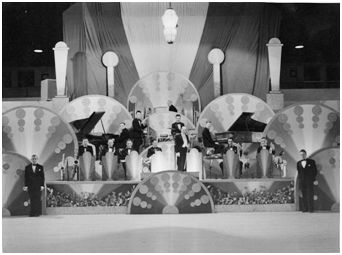
Whilst at Falkirk the band leader Joseph A Gibson stayed at 55 Vicar Street. In November 1943 he and his band were replaced by Harold McArdle and the Falkirk Ice Rink Dance Band. The following table gives a flavour of the bands which performed at the Falkirk Ice Rink.
| BAND | DATE |
|---|---|
| Felix Mendelssohn and his Hawaiian Serenaders | August 1942 |
| George Elrick and his band “the smiling voice of radio.” | August 1942 |
| Polish Army Choir and Folk Band | September 1942 |
| Lew Stone and his Band | March 1943 |
| George Elrick and his Band | March 1943 |
| George Scott-Wood and his Band | May 1943 |
| Jerry Hoey and Band | February 1944 |
| Bo’ness Pipe Band | June 1944 |
| Phil Green and his Dixieland Orchestra | July 1944 |
| The Savoy Havana Band | September 1944 |
| Sammy McLean and his Band | December 1944 |
| Carl Barriteau’s Band ( a coloured band) | July 1945 |
Many of the local cinemas objected to entertainment concessions being granted to the Falkirk Ice Rink as it was seen as a direct competitor. This was emphasised when in October 1942 the Ice Rink took a step back into cinema history and acquired a cinema organ. The Lafleur organ had been used by the BBC to fill in for blank air space following the declaration of war on 3 September 1939. Appropriately, Gerald Shaw, the famous BBC organist, was the first to play the instrument at Falkirk. It was probably the only ice rink in Scotland to have such a feature. Another organist star of radio and recording, H. Robinson Cleaver, played it in May and June 1943.
Harry Benet’s International Circus was touring a two hour show at Britain’s largest theatres and in July 1943 included Falkirk Ice Rink. It drew exceptionally large crowds to see performances such as the trapeze acts by the flying Cromwells.

As well as giving concessions to serving military personnel and entertaining wounded soldiers from the Falkirk area the Ice Rink saw the presence of foreign troops. Polish soldiers were billeted in huts at the back of the rink at the far end of the car park. Other Poles were placed at Camelon, Carron, Kinnaird, Grangemouth and Polmont and often attended the Ice Rink. Incidents occurred between these men and locals – usually with a young woman involved. Consequently Polish military police were stationed at the restaurant in the Ice Rink to stop such occasions from getting out of hand. An unusual incident happened in March 1943 when Jozef Kulczyski, a Polish airman serving with the RAF, brandished an open jack-knife at the Rink, causing fear and alarm. He had been drinking and was upset because the girls would not dance with him.
Military families attended drumhead services held at the Ice Rink and organised by the Falkirk Branch of the British Legion (Scotland). The Home Guard were also to be seen in the vicinity of the Ice Rink. In the days leading up to D-Day they were tasked with policing the prohibited coastal area which included Grangemouth and Bo’ness. The Grangemouth people were still allowed to visit the Ice Rink but the Falkirk bairns were not allowed to travel to Grangemouth except for work. Buses were stopped at the Ice Rink or at Muirhead’s Sawmill and identity cards checked. Places like the Ice Rink came to be seen as neutral territory between Falkirk and Grangemouth and so wedding parties for mixed couples – that is to say with one partner from Grangemouth and the other from the Falkirk area – were held there, enabling both families to attend.
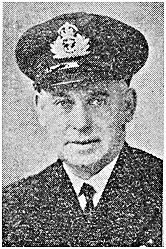
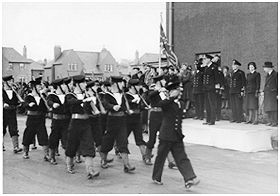
The uniforms of youth movements like the Girls’ Guildry were also a common sight at the Ice Rink. The movement most associated with the place was the Sea Cadets whose commanding officer was Festus Moffat. He was able to secure the use of the ice rink for the Falkirk Sea Cadets which made it a popular unit. Indeed, Falkirk had one of the largest units in the whole of Britain – quite an achievement for such a landlocked location (Bailey 2013, 117-137).
In September 1942 the Falkirk Sea Cadets held their first annual review at the Ice Rink putting on a fine display of ice skating and entertainment. The second annual naval display featured signalling, gymnastics, gun drill, ship manoeuvres, boxing, physical training and rope work. The third annual performance in September 1944 was called “Action Stations” and had a mock aircraft carrier and an approaching boat which somehow led to demonstrations of semaphore, fencing, rope splicing, flaking and coiling, whaler drill and gymnastics. By then the Sea Cadets had a full brass band and a bugle and drum band – both of which performed at the Ice Rink.
.
8 May 1945 was VE Day – some 5,000 very happy people were to be found at the grand victory dance held in Falkirk Ice Rink that evening. The seating accommodation was full and yet every available space on the dance floor was taken up. Queues lined the avenue which led to the main door till almost ten o’clock and somehow they all managed to get in. The euphoria was unforgettable as they shuffled about on the dance floor under a busy tapestry of flags of all the allied nations. A huge V sign was formed from electric lights at one end of the hall. The Polish soldiers were not so happy and spent much of the night attempting to remove the Russian flag which hung close to the restaurant.
.
Over the following months the district welcomed home its sons and daughters who had served abroad. Many were returning from imprisonment. Many events were held at the Ice Rink to raise funds for their homecoming. A variety entertainment under the title of “Forces’ Welfare” was held on 27 May 1945 for Falkirk Burgh, and a second on 24 June for the Grangemouth Welcome Home Fund.
.
The war was over but reminders of it emerged every now and again. On the night of the 6 April 1946 an explosion of a munitions dump near Callendar caused damage over a huge area. Film goers at the Cinema de Luxe in Denny evacuated the building believing that part of it had collapsed and at Falkirk Ice Rink a window was shattered and the whole building quivered.
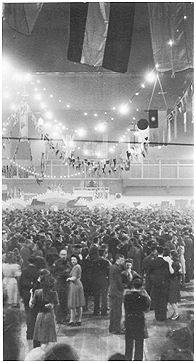
G.B. Bailey, 2022
To read about the British Open Curling Championship, CLICK HERE.
